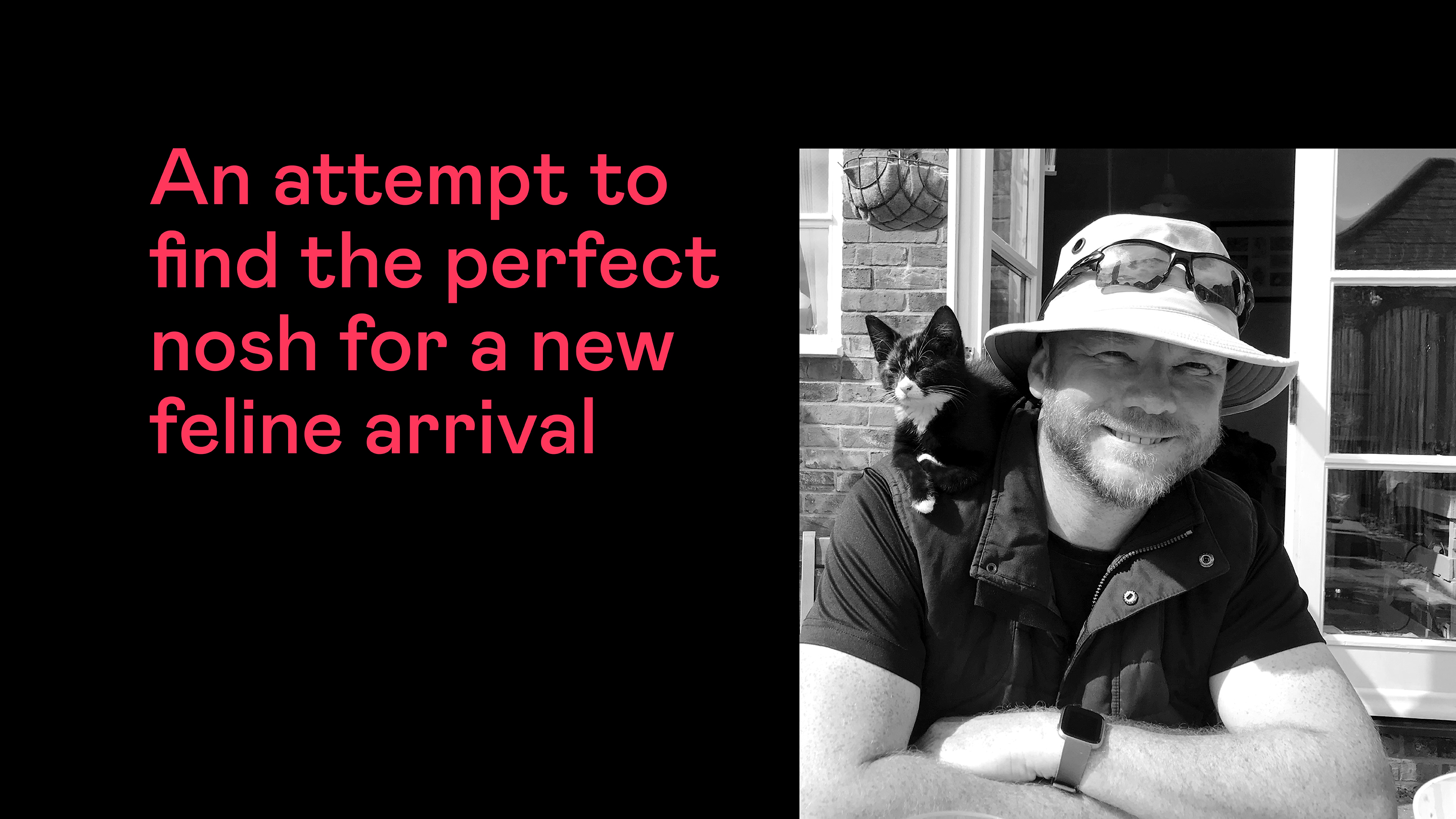An attempt to find the perfect nosh for a new feline arrival provided some wider lessons on branding.
It’s not often you find yourself standing in an aisle, staring at massed ranks of unfamiliar brands, wondering what to do next. But that’s the situation I found myself in, after the arrival of our cat. As I stood there, letting my senses and brain soak in the multitude of choices, I realized that I had a rare opportunity to experience a pristine customer journey.
I could test myself against the brands: how would I prioritize choices, deconstruct pack semiotics, respond to advertising, and lean on advisers? How would I blend digital and real experience? Would I be rational or emotional? I decided to monitor my responses to find out.
First, the starting point for any brand – the consumer profile: our catsumer’s called Esme Weatherwax, Waxie for short. She’s from Nottingham, but now lives in a village in a two-marketer household. She’s a black, white and ginger moggy, and is now one year old. Any talk of her being a lap or house cat disappeared within days of her arrival, as she attempted to scale the neighbors fence to chase his chickens.
So her attitudinal profile is spirited and adventurous. She also has a history of health problems, arriving with a digestive issue. Her hobbies are chicken harassment, tree-climbing and generally pretending to be a tiger. She’s keen on episodes of The Yorkshire Vet in which the vet gets trodden on or bitten, and she does consume traditional media, but only via the litter tray.
But what do you feed a cat? I started my journey the old-fashioned way, with a trip to an enormous, big-box pet-food shop.
Childhood brand
I vaguely recalled Whiskas from my childhood cat. In my mind, the brand was the category standard. Safe, predictable, and served by the Pharaohs. Sure enough there it was, a confident and reassuring presence on the shelf, resplendent in an Imperial purple offset by some jolly typography and optimistic yellow. I wasn’t quite sure why the slightly worried looking cat was trying to climb out of a hole though.
And that was the first moment of truth – the personality conveyed by the imagery. Almost every pack prominently featured a picture of its furry brand ambassador. This prompted some immediate eliminations: Waxie is a cool cat (not that I’m biased) and some of these didn’t fit with her (projected) identity at all.
Imperial and haughty
The Duchess cat looked disdainful, with a haughty profile. Hardly surprising with a name like that. And once again the imperial purple and crown icon completed the brand. Too uppity for Waxie. The Gourmet cat was along the same lines.
The Duchess also raised questions about sustainability, as the pack structure was plastic pouches.
With two brands down, advertising started to play its part in the marketing mix. I spotted Sheba. Sheba’s latest campaign features an attractive middle-aged woman wiping her face on a cat. At least that’s what it looks like. That cat was on the pack and, wow, did it look dejected at the experience. Lying on its side, directing a mournful “help me” look at the camera, set against a gloomy black background. I suspected this cat was being held prisoner by the face wiper. OK it’s supposed to be premium, sophisticated and intimate, but it was abundantly clear I wasn’t the target market.
Natural vs fun vs function
The remaining brands now split into two broad camps: natural versus fun. Hi Life’s tone of voice stood out: “the fishy one”, the playful dual message of “it’s only natural”, and “50% fish, 100% natural, 200% loved” immediately appealed to my sense of humor. And the cat looked perky, just like Waxie. I was sold.
Except I wasn’t, because I had neglected my stakeholder management. I was shopping with my wife, who by this point had heard just about enough nonsense about the gestalt of cat. I was reminded that the catsumer – in other words, not me – had stomach issues, and that nutrition should be our sole consideration. Function, not emotion, should be our guide. And my wife’s extensive online research had informed her that Purina had the best product formulation.
And sure enough, the brand did indeed look like the choice of the responsible fur-parent.
The brand’s purpose aligned with our personal values, responsibly placing the needs of the animal first. It also set out a “nutritional philosophy”. A rather grand title, but it did convey how seriously the brand took its mission, and it explained how it went about it with scientific rigor.
Having switched on to the rational criteria “nutrition”, we methodically worked through all the brands’ proof points and claims. The switch from personality to functionality had immediately increased their importance.
Wellness and the winner
Core and Lily’s Kitchen – fitted with several current human lifestyle and nutrition trends. Lily’s is organic “proper food’, and Core is branded as “Wellness” and “rich in protein”. But Core felt a bit “yoga mum” for me, and Lily’s was frankly a mite too feminine, so these late contenders fell away.
Exhausted, bewildered and dazzled by complexity, we made our choice. But of course, the brand is not the experience. And our catsumer soon made her opinion abundantly clear, by being sick all over the kitchen.
Expert advice was sought, in the form of a reassuringly white-coated vet with a patrician tone of voice. The key word was natural. This simple instruction proved to be the key to completing the journey. With this North star to guide us, all other considerations were relegated. Web searches could finally be directed accurately, and proof points matched against a clear scorecard.
A winner emerged: Applaws. After all the complexities around personality, image and price, its simplicity cut through.The only hint of personality was the naming, with the smart use of a coined term combining applause and paws.
Thankfully the catsumer’s digestive system agreed this time and, a year on, she’s a healthy and happy brand loyalist.
The branding lessons
1. Branding is a multi-faceted and immersive experience: purpose, proof points, positioning, packaging and promotion all played a role in the decision making.
2. Brand management needs to balance both short and long term: the immediate mixes with the embedded, as new information challenges long-held assumptions, perceptions, and memories.
3. Personality – the natural and immediate identification with a brand – drives a strong instinctive response, which filters brands by me/not me. So brands need to be clear with their attitudinal segmentation, targeting and identity.
4. Purpose underpins brands. They provide a level of comfort about alignment with personal aims and values that builds trust and association. Every brand needs one to add layers of richness to its relationships.
5. Experts and influencers matter. Nurture your relationships with a wide ecosystem of brand ambassadors, they’re a vital source of objective information for the slightly bewildered purchaser.

